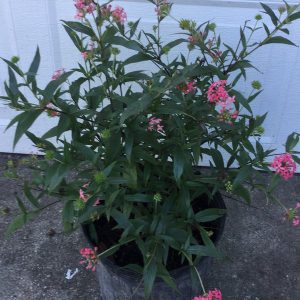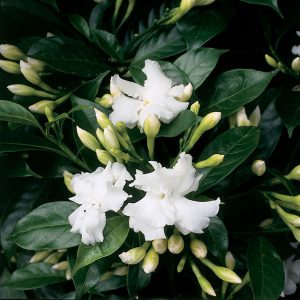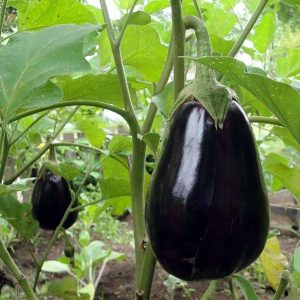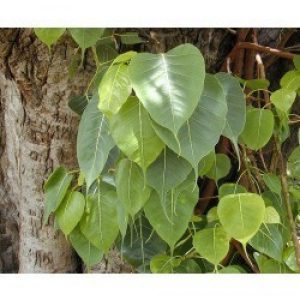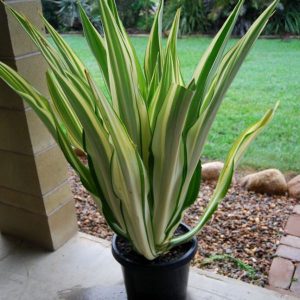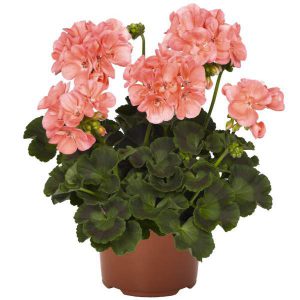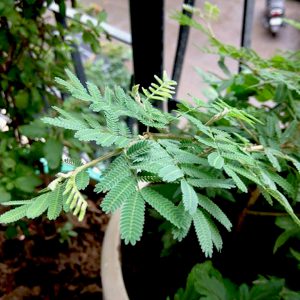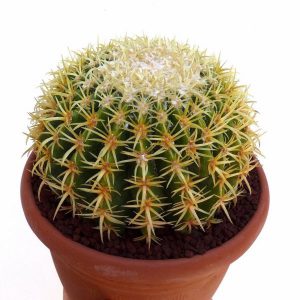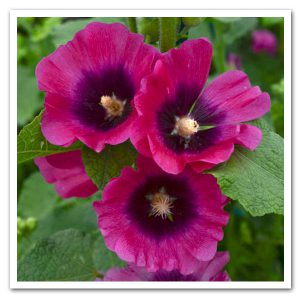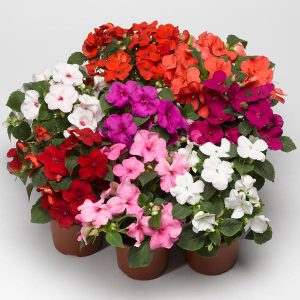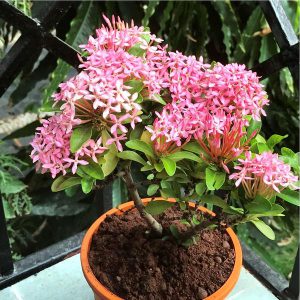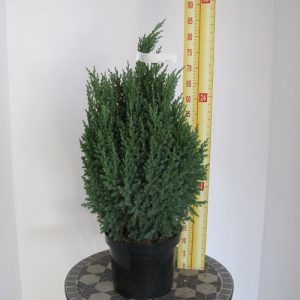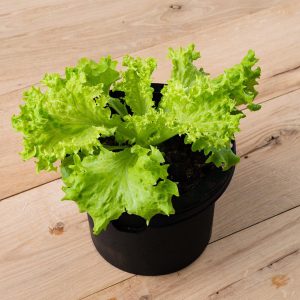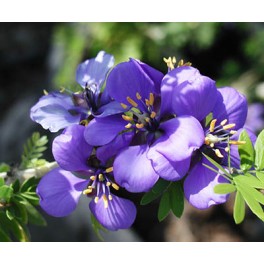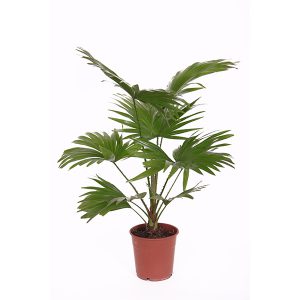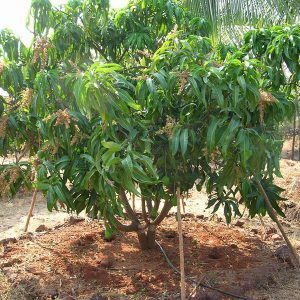Outdoor Plants
conocarpus erectus var
This low-branching, multi-trunked, shrubby, evergreen tree has beautiful silvery leaves due to silky hairs which cover the leaf surface (Fig. 1). The inconspicuous, small, greenish flowers appear in dense conelike heads in terminal panicles in spring and are followed by 1/2-inch, conelike, red-brown fruits. The dark brown attractive bark is ridged and scaly. The leaves are small and fall between the grass blades of the lawn or are easily washed away in the rain.
AED 0.00Read more
crepe jasmine TABERNAEMONTANA CORONARIA
Although the shrubs look elegant and refined, they are not at all picky about soil as long as it is well drained.
If you are growing crepe jasmine, you can plant the shrubs in full sun or partial shade. They require regular irrigation to keep the soil moist. Once the root systems are established, they require less water.
Crepe jasmine care is reduced if you are growing the plant in acidic soil. With slightly alkaline soil, you’ll need to apply fertilizer regularly to prevent the shrub from getting chlorosis. If the soil is very alkaline, crepe jasmine care will include more frequent applications of fertilizer.
AED 90.00Add to cart
Deseret rose
Plant lovers are always looking for easy to grow, unique plants with a fun aspect. Adenium desert rose plants are perfect specimens for the intrepid or novice gardener. These East African and Arabian natives are wonderful in the interior container garden or as warm climate additions to the patio display. Caring for desert rose plants requires a full sun location and well-drained soil. Properly mimicking their native regional conditions will garner plenty of rose-like blooms on an architectural marvel of a plan
AED 45.00Add to cart
Dodonaea viscosa green
The hop bush has an excellent, natural shape and seldom requires pruning. Only prune hop bush to reduce its size or to remove dead or damaged foliage in the spring. Water deeply once a month in the summer, and rely on rainfall in the winter.
AED 15.00Add to cart
durant erecta (sapphire shower)
The “Sapphire Showers” golden dewdrop (Duranta erecta “Sapphire Showers”) adds interest to the landscape with its clusters of bluish-purple, trumpet-shaped flowers. Flowers appear in summer and attract butterflies. Also known as Picotee sky flower or pigeonberry, this fast-growing specimen prefers full sunlight and well-draining, slightly acidic soils.
AED 60.00Add to cart
Echino cactus Grusonil
Echinocactus grusonii, commonly known as mother-in-law’s cushion, stands out especially due to its golden spines, which form a beautiful contrast to the lush green of the cactus’ body. In addition, this cactus species is exceptionally robust and does not come with many requirements in terms of tending. Learn from these professional care instructions what exactly it is that your cactus needs.
AED 40.00Add to cart
egg plant
The range of sizes, shapes, and colors of the heat-loving eggplant (Solanum melongena) tells the story of its enduring popularity. Native to India, where it grows wild, it has been cultivated in Southeast Asia for thousands of years.
Europe was introduced to the vegetable in the 8th century via the Moors, who brought it to Spain, Sicily, and southern France via North Africa. In the sunny, dry climate of the Mediterranean basin, eggplant found the warm growing conditions it prefers and soon found its way into the classic cuisines of the region.
AED 45.00Add to cart
eranthemum nigrum black kodia plant
The Eranthemum nigrum is also known as Black Kodia.
The subtropical climate is said to be the best for the growth of the plant.
The plant is grown widely as an ornamental plant.
The special feature of the plant is that it can grow anywhere. It has no specific requirements or conditions for growth.
The plant produces attractive white flowers from summer to fall.
AED 25.00Add to cart
Ficus benjamina
Ficus benjamina, commonly known as weeping fig, benjamin fig or ficus tree, and often sold in stores as just ficus, is a species of flowering plant in the family Moraceae, native to Asia and Australia. It is the official tree of Bangkok.
Plant Care
- Keep Ficus benjamina plants in large planting pots filled with a soil-based potting mix. …
- Place pots indoors in bright indirect light, and outdoors in full sun to part shade.
- Let the soil around the shrub dry out between waterings.
AED 165.00Add to cart
Ficus bonsai Ginseng
Ginseng Ficus is a low-maintenance bonsai that can be grown indoors or outdoors. Of course if you live in an area where temperatures drop below 68 degrees, your little tree should be grown indoors. This type of bonsai can survive without direct sunlight, but you will have a much happier and healthier tree if you place it near a window or an area that receives a lot of sunlight.
AED 85.00Add to cart
ficus carica (fig)
Ficus carica, commonly called common fig, is a deciduous shrub (to 10-15’ tall) or small tree (to 15-30’ tall). It is noted for its spreading habit, attractive foliage and edible fruit. Old trees with smooth silver-gray bark (sometime gnarled with age) are ornamentally attractive. Large, palmate, hairy, 3-5 lobed leaves (to 10” long) are rough dark green above and smooth light green beneath. Non-showy greenish flowers form in spring inside hollow receptacles near the branch growing tips. The fruit (edible fig) develops within each receptacle. The main fruit crop ripens in late summer or fall on new wood. In some areas, a lesser crop may appear in spring on new wood. Species plants as well as most fig cultivars are parthenocarpic (fruits develop without cross pollination).
Genus name comes from the Latin name for Ficus carica the edible fig.
Specific epithet refers to Caria, a district in Asia Minor known for growing figs.
AED 150.00Add to cart
ficus panda
Ficus (genus Ficus), a group of about 900 species of trees, shrubs, and vines, commonly called figs. Native primarily to tropical areas of East Asia, they are distributed throughout the world’s tropics. Many are tall forest trees that are buttressed by great spreading roots; others are planted as ornamentals.
The always popular ficus tree is a member of the fig family and perfect for caring for as a houseplant. There are several varieties of this plant that are grown as houseplants. Among these are the ficus benjamina or weeping fig, the ficus lyrata or fiddle head fig, and the ficus elastica decora or rubber tree. The Bodhi tree, under which the Buddha achieved enlightenment, is believed by many to have been a ficus religiosa. The most popular as an indoor tree is the ficus benjamina.
AED 230.00Add to cart
ficus religiosa
Grow bodhi trees outdoors in the garden in areas with little or no frost. The National Taiwan University reports that bodhi trees will not survive minimum winter temperatures below 50 degrees Fahrenheit while the Missouri Botanical Garden website states that they are hardy down to 30 degrees F.
AED 0.00Read more
furcraea foctida
Growing F. foetida is as simple a matter as keeping its soil drained and making sure it receives an adequate amount of sunlight. These plants are drought-resistant and need to be watered only infrequently—in the wild, they often grow on rocks or cliffs—and they prefer full sun. If you’re growing them in pots rather than your garden, make sure the soil stays fairly dry and repot if necessary.
AED 240.00Add to cart
gazania rigens
gazania rigens
Grow in sandy to average, well-drained soils in full sun. Tolerates some soil dryness, but prefers consistent moisture. Do not overwater, however. Deadhead spent flowers to encourage additional bloom. Winter hardy to USDA Zones 9-11. Grow as annuals in St. Louis, either in the ground or in containers. Prefers cool summer climates, and flowering may slow down considerably in hot and humid St. Louis summers. If growing from seed, start plants indoors in late winter (6-8 weeks before last frost date) and set plants outside after last frost date. Take basal offsets from favorite plants in late summer to early fall for rooting and subsequent overwintering indoors in pots. Container plants may also be brought inside for winter.
AED 5.00Add to cart
geranium
Whether indoors or out, geranium care is pretty basic. In addition to watering, which should be done deeply and once the soil begins to feel dry indoors or at least weekly outdoors (though potted plants may need daily watering in hot weather), fertilizing is usually necessary. Use a water-soluble houseplant fertilizer or a 5-10-5 fertilizer with additional organic matter every four to six weeks throughout their active growing season. Indoor or potted plants may require repotting once they become overgrown, usually noted by wilting between waterings. Regular deadheading of spent blooms will also help encourage additional blooming. When watering outdoor plants, it’s best to avoid overhead irrigation, as this can lead to pests or disease issues. Geranium plants root easily from cuttings and can be propagated in fall for overwintering of outdoor plants. They can also be dug up and brought inside.
AED 10.00Read more
Gerbera daisy
Gerbera daisies are susceptible to fungal diseases, although older varieties less so. Fungal sprays do not generally prevent crown rot, so correct planting and watering are essential for gerbera daisy care. Make sure you plant them with adequate spacing and in high light areas. A little bit of light shade in high summer is alright, but without full, direct light the plants will get leggy and pale and not produce nearly as many blooms. Water in the morning so leaves can dry out during the day to lessen the risk of rot and fungal diseases. Gerbera daisy care can also be enhanced by using a micro-nutrient liquid fertilizer such as a seaweed or fish emulsion. Keep an eye out for caterpillars and leaf miners too. Spray, if needed, with an organic spray such as pyrethrum or neem oil. Growing gerbera daisies can have some challenges, but it is a wonderful reward when those big, happy flowers bloom.
AED 20.00Add to cart
Ghaf national tree of uae (prosopis cineraria)
Ghaf trees (Prosopis cineraria) of UAE are considered as the National tree of UAE. In Abu Dhabi they are seen in the north eastern part of the Emirate. They are the largest trees in the sand sheets and dunes which depend on ground water for its survival. They have striated trunk, bipinnate leaves and have small thorns at the younger stage. The flowers are yellow and fruit is a pod which encloses several seeds.
The ghaf trees are a part of tradition and culture of UAE. The leaves are used as fodder, and also used as salad as they are rich source of protein; the honey from the flowers is of high quality. They have been used traditionally for medicinal purposes as well. They provide shade and shelter for humans and animals. They provide microhabitat for plants, birds and insects. Birds such as eagle owl and ravens built their nest on the tree
AED 90.00Add to cart
Golden Barrel Cactus
Echinocactus grusonii, popularly known as the golden barrel cactus, golden ball or mother-in-law’s cushion, is a well known species of cactus, and is endemic to east-central Mexico
- Keep your cactus at low to moderate temperatures averaging between 50 and 75℉ during the day. …
- The golden barrel cactus grows best when given plenty of sunlight. …
- During warm months, you should water your golden barrel cactus on a regular basis whenever you start to notice the soil drying out.
AED 40.00Add to cart
grevillea roobusta (silk oak tree)
This is a fast-growing, single-stemmed, semi-deciduous tree, losing most of its leaves just before flowering. The bark is dark grey and furrowed in a lace-like pattern. The leaves can be over 30 cm long, fern-like, green on the upper surface and pale and silky below. The bright orange flowers are borne in many pairs along flower spikes. The flowers produce plenty of nectar so is very attractive to birds, bees and other insects. Height 25m Spread 15m.
hamelia patens
Light: Does best in full sun but quite well in partial shade. It becomes leggy in shade.Moisture: Once established, firebush is drought tolerant, but it does best with frequent watering as long as the soil has excellent drainage. Water weekly during the first year after transplanting.Hardiness: USDA Zones 8 – 11. Firebush is like coral bean: it is a semi-woody shrub or small tree in zones 10-11, and a perennial that dies to the ground in winter and sprouts back in spring in zones 8-9. Firebush also is grown as an annual or a potted plant in colder zones.Propagation: Propagate by soft wood cuttings in spring or by seed.
Hamelia patens is an evergreen shrub, usually growing 1.8 – 3 metres tall, though sometimes becoming a tree up to 5 metres tall with a short bole around 8cm in diameter[
AED 15.00Add to cart
Heliconia olympic dreem
Tropical flowers never fail to astound and amaze with their forms and colors. Lobster claw plant (Heliconia rostrata) is no exception, with large, brightly hued bracts that cluster up a stem. Heliconia lobster claw is also called parrot flower and has inconsequential tiny flowers covered by the showy bracts. It is native to Central to South America and is hardy in the United States
AED 200.00Read more
Hibiscus
Select a site with full sun and well-drained soil. Hibiscus also adapt well to growing in containers.
Plant in spring, summer, or fall, spacing plants 3 to 6 feet apart. Dig a hole only as deep as the root ball and 2 to 3 times as wide. If your soil is in very poor condition, amend the soil you’ve removed from the hole with a small amount of compost. Otherwise don’t amend it at all. Carefully remove the plant from the container and set it in the hole. Fill the hole half full with soil, then water it well to settle the soil and eliminate air pockets. Let the water drain, then fill the remainder of hole with soil and water thoroughly.
Hibiscus require at least 1 inch of rain (or equivalent watering) each week. They like to be constantly moist, but not wet. Feed twice a month during the growing season and prune as necessary to control plant size and cut back errant branches. Cut branches back to just above a side shoot. Hibiscus are sensitive to cold and should be protected when temperatures dip into the 30s; container-grown plants should be brought indoors
AED 35.00Add to cart
Hollyhocks plants
The flowering stalks of the hollyhock, Alcea rosea, are covered in buds from the top all the way down to the rosette of foliage at the base. Once they are fully grown and ready to burst into color, these blooms start at the bottom and slowly work their way up, unfurling a little at a time. As the blooms continue to open, there will typically be several blooms per stalk all opening at once to create beautiful columns of rainbow-worthy color.
AED 45.00Add to cart
impatiens
Impatiens is one of the most popular annual flowers, due to their brightly color blooms and their ability to grow in shady areas. The most commonly grown cultivars are short plants, attaining a height of not more than 1 foot. Some types, such as the ‘Super Elfin’ series, stay much shorter. Impatiens flowers come in a variety of colors, including white, red, pink, violet, coral, purple, and (a relative newcomer) yellow.
AED 15.00Read more
Ixora plant
The best floral displays are produced by Ixora grown in full sun situations. Well-drained soil and moderate to slightly acidic pH are crucial to growing an Ixora bush. The plant develops chlorosis when installed in alkaline soils. Keep the soil evenly moist and prune the plant when it gets unruly. Ixora responds well to shearing and makes an excellent low hedge with its 4 to 6 foot height. Propagation of the shrub is through stem cuttings which can be rooted with the help of a rooting hormone. The flowers also occasionally produce a dark purple to black berry with seeds that are sometimes viable. Clean the pulp off the seed and soak it over night. Plant in a 2-inch pot filled with good seed starter mix. Moisten the mixture and fasten a plastic bag over the pot. Place in a warm location with moderate light. Keep the pot moist and move it to bright light as soon as the seed has germinated.
AED 25.00Add to cart
Jasmine (millingtonia hortensis)
The jasmine tree (Millingtonia hortensis) has a number of other common names, including cork tree and nim (in Hindi), because this beautiful tree originates in Asia, and flourishes wild and through cultivation, in India. Its botanical name honors Thomas Millington, an 18th century English botanist. The tree is mainly ornamental in character, tall and graceful, reaching heights of around 80 feet, but not especially hardy, with fairly sparse, brittle branches and bark. However, regular pruning can keep the tree small if desired. The tree’s clusters of delicate, bell-shaped, silver-white flowers bloom in the spring, and again around November and December. They bloom at night and shed their flowers by morning. In India, the flowers are used in religious rituals. New pointed, oval leaves come through in the spring. The jasmine tree is a member of the Bignoniaceae family.
Juniperus chinensis outdoor
- Easily transplanted
- prefers moist, well-drained soil, but very adaptable
- full sun
- pH adaptable
- once established little maintence required
AED 250.00Read more
lawsonia inermis (henna tree)
Even though you may grow henna plant indoors with the assurance of direct sunlight, it is always preferred to grow it outdoors. This is because henna plants grow better in hot climates. The minimum temperature needed for a henna plant to grow and nourish well is 22ºC.
AED 50.00Add to cart
lettucc boston (organic)
Succession planting is the key to growing lettuce if you want a steady supply of lettuce for salads and sandwiches. From spring through fall, Thomas Jefferson planted a teaspoon of lettuce seeds every Monday at Monticello, so they’d have lettuce all summer long.
For home gardeners, planting a small patch where you have a gap in the garden every 2-3 weeks will give you a steady supply through the summer. Container gardeners or balcony farmers can start new salad trays or planters every few weeks.
AED 25.00Add to cart
lettucc frisee (organic)
A type of frisee endive with very fine, branched leaves. Frisee Organic Chicory Seeds produce a frisee endive variety that is tolerant to necrosis, and is known for its early development of compact heads. With excellent flavour and its heavy weight, this is an outstanding market variety for whole head or baby leaf production. Plants can be blanched by bunching the outer leaves together at the top with an elastic band, or by placing a cardboard disc over the plants before harvest. Blanched endive is a bit sweeter, and even sweeter when lightly cooked.
AED 25.00Add to cart
lettucc lollo green
Lollo Bionda (pale green) and Lollo Rosso (red) are terms used referring to types of fancy lettuce with tight curly leaves, otherwise known as coral lettuce. The leaves are produced loosely in a whole head, are tender in taste, with a slight bitterness.
These very decorative lettuce types add a punch of colour, texture and volume to salads. The curled leaves also have a practical function as they increase the surface area enabling salad dressings to be caught up in the leaf and not to the bottom of your salad bowl.
Recently breeders have selected varieties with smaller leaves that easily separate with just one cut at the base and have become very popular in ready to eat leafy salad mixes.
AED 25.00Add to cart
leucaena leucocephala (white tamarind)
Suitable for: light (sandy), medium (loamy) and heavy (clay) soils and prefers well-drained soil. Suitable pH: acid, neutral and basic (alkaline) soils and can grow in very acid, very alkaline and saline soils.
It cannot grow in the shade. It prefers dry or moist soil and can tolerate drought. The plant can tolerate maritime exposure.
leucophyllium
Tips
- The height of a Texas sage bush depends on its environment. It stays compact and short, up to about 5 feet tall, in arid conditions. Plants tend to grow more than 8 feet tall in gardens where they receive water that supplements rainfall.
- Compact Texas sage varieties are good for large containers. Shorter cultivars include “Compacta,” which has pink flowers.
AED 25.00Add to cart
lignum (guaiacum officinale)
Loved for its purple to blue-violet flowers that yield bright red fruits, lignum vitae is heat, drought and salt tolerant, making it stupendous as a specimen in the coastal tropics. A rounded evergreen tree from the northern coastline of South America and the Caribbean islands, it is extremely slow growing and has a crooked, knotty form that adds to its beauty. The wood is very dense and does not float.
AED 110.00Add to cart
Livingstonia
Chinese Fan Palm is a BIG plant with sprawling fanlike fronds that grow up to 2 ft (60 cm) across.
When mature, this palm is a picture of elegance. Its broad, fan-shaped foliage is carried on tall stems, making it a graceful ornamental for the home. Treat it right and you’ll enjoy your Chinese Fan Palm for many years.
Put it in a bright spot, but out of direct sunlight. You’ll find that this palm is adaptable to average home temperatures and is easy to please.
Older fronds may turn brown. Cut off old fronds near the trunk, using sharp pruners.
Brown leaf tips are fairly common on indoor palms,
AED 205.00Add to cart
Maidenhair fern fragrance
If you’ve ever grown (or killed) a maidenhair fern, you’ll know that these delicate, lacy beauties are quite picky when it comes to their growing conditions. We’ve featured plenty of tough-as-nails plants (spider plants, Chinese evergreens, cast-iron plants, and dracaena) that can tolerate a wide range of conditions, but maidenhair ferns are the opposite. As long as you know that there’s no fooling around when it comes to meeting its needs, though, this fern will reward you with gorgeous foliage. Here is what you need to know to keep a maidenhair fern thriving.
Mango
The juicy, ripe mango fruit has a rich, tropical aroma and flavor that summons thoughts of sunny climates and sultry breezes. The home gardener in warmer zones can bring that taste out of the garden. However, how do you grow a mango tree? Mango tree planting is suitable in zones where temperatures do not usually dip below 40 F (4 C.). If you’re lucky enough to live in a tropical to sub-tropical climate, take these tips for mango tree care and enjoy the fruits of your labors in just a few years.
AED 110.00Add to cart
Marrigold
- Marigolds are a favorite, no-fuss annual that can bring the color of sunshine to your garden, as well as butterflies, bees, ladybugs, and other beneficial insects. Give them full sun and some well-draining soil and watch them bloom from late spring until fall.
- Marigold plants germinate quickly, within just a few days, and bloom in about 8 weeks. This quick sense of satisfaction makes them a great first-time gardening project for kids and garden newbies. Not to mention, marigolds are a great companion in your vegetable garden and can help protect your veggies from predators and pests.
- It is best to water marigolds at the base of the plant and not from overhead. The densely double flowerheads will tend to rot with excess moisture. Allow the soil to dry somewhat between waterings, but do water regularly in high heat or dry weather. Marigolds growing in containers should be watered daily as containers dry out quickly.
AED 25.00Add to cart

